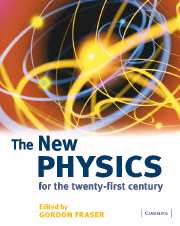Book contents
- Frontmatter
- Contents
- Contributors
- Editor’s acknowledgements
- Introduction: The new physics for the Twenty-First Century
- I Matter and the Universe
- II Quantum matter
- 6 Manipulating atoms with photons
- 7 The quantum world of ultra-cold atoms
- 8 Superfluids
- 9 Quantum phase transitions
- III Quanta in action
- IV Calculation and computation
- V Science in action
- Index
- References
7 - The quantum world of ultra-cold atoms
Published online by Cambridge University Press: 05 June 2014
- Frontmatter
- Contents
- Contributors
- Editor’s acknowledgements
- Introduction: The new physics for the Twenty-First Century
- I Matter and the Universe
- II Quantum matter
- 6 Manipulating atoms with photons
- 7 The quantum world of ultra-cold atoms
- 8 Superfluids
- 9 Quantum phase transitions
- III Quanta in action
- IV Calculation and computation
- V Science in action
- Index
- References
Summary
Introduction
This chapter describes remarkable new experiments that have been made possible through recent advances in laser cooling of atoms. Cooling of atoms in a gas by laser light is in itself surprising and this technique is important in a range of applications. In particular the experiments described here take atoms that have been laser cooled and then use other methods to reach even lower temperatures, at which wonderful and fascinating quantum effects occur. As well as revealing new phenomena, these experiments explore the deep analogies between the roles played by light waves in lasers and matter waves. These techniques are widely accessible and enable skilled researchers in laboratories all over the world to explore exciting new physics. The key physics and techniques of laser cooling are described in depth in Chapter 6.
What is “temperature”?
We use the words “cold” and “hot” every day; for example to refer to the temperature of the air outside. But what do “cold” and “hot” mean for the air’s molecules? Broadly speaking, we can say that atoms in a hot gas move faster than those in a cold gas and that cooling, by taking energy out of the gas, slows the atoms down. In this description of the gas as a collection of atoms behaving like billiard balls, or little hard spheres, the lowest possible temperature occurs when the atoms stop moving but, as we shall see, this picture does not give an accurate description at very low energies, for which quantum effects become important. In this chapter we will look at the fascinating properties of atomic gases cooled to temperatures within one millionth of a degree Kelvin from absolute zero. We shall use the term “ultra-cold” to refer to such extremely low temperatures that have only recently been achieved in experiments on atomic gases. The techniques used to cool liquids and solids have a longer history and have made available a different set of possibilities (see Chapter 8). Note that most of this chapter refers to gases in which the individual particles are atoms, but the general statements about temperature scales apply equally well to gases of molecules, e.g. air, whose major constituents, oxygen and nitrogen, exist as diatomic molecules.
- Type
- Chapter
- Information
- The New PhysicsFor the Twenty-First Century, pp. 171 - 199Publisher: Cambridge University PressPrint publication year: 2006

